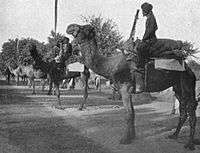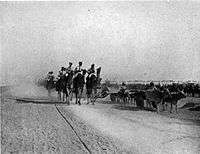Zamburak
Zamburak (Persian: زمبورک), literally meaning wasp, was a specialized form of self-propelled artillery from the early modern period, featuring small swivel guns mounted on and fire from camels. The operator of a zamburak is known as a zamburakchi. The weapon was used by the gunpowder empires, especially the Iranian empires of the Safavid dynasty, Timurid Empire and Afsharid dynasty, due to the ruggedness of the Iranian Plateau, which made typical transportation of heavy cannons problematic.

17th century Persian artilleryman operating a Zamburak | |
| Active | After 1499 |
|---|---|
| Country | Greater Middle East East Asia |
| Branch | cavalry |
| Equipment | rifle, artillery |
The zamburak became a deadly weapon in the 18th century. The Pashtuns used it to deadly effect in the Battle of Gulnabad, routing a numerically superior imperial Safavid army. The zamburak was also used successfully in Nader's Campaigns, when the shah and military genius Nader Shah utilized a zamburak corps in conjunction with a regular artillery corps of conventional cannon to devastating effect in numerous battles such as at the Battle of Damghan (1729), the Battle of Yeghevārd, and the Battle of Karnal.
Use
Zamburaks were one of the royal guard units in the Qajar Army. A Persian zamburak regiment would be accompanied by musicians with huge camel-mounted drums, in order to create even more noise and impress the enemy. Zamburaks were used against the invading British in the Anglo-Afghan Wars and in the Anglo-Sikh wars.
A zamburak consisted of a soldier on a camel with a mounted swivel gun (a small falconet), which was hinged on a metal fork-rest protruding from the saddle of the animal. In order to fire the cannon, the camel would be put on its knees. The name is derived from the Persian word for wasp zambur (زنبور), possibly in reference to the sound earlier camel-mounted crossbows made. The mobility of the camel combined with the flexibility and heavy firepower of the swivel gun made for an intimidating military unit, although the accuracy and range of the cannon was rather low. The light cannon was also not particularly useful against heavy fortifications.
The Dzungar Khanate used camel-mounted miniature cannons in battle.[1]:89 Gunpowder weapons like guns and cannons were deployed by both sides during the Dzungar–Qing Wars.[1]:95
After 1850, Gatling guns were mounted on camels as well.
References
- Millward, James A (2007). Eurasian Crossroads: A History of Xinjiang. Columbia University Press. ISBN 978-0-231-13924-3.

